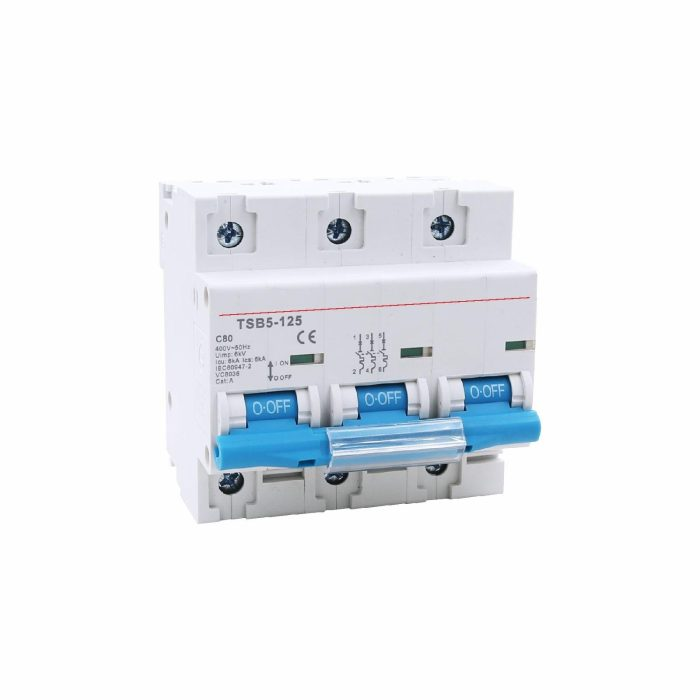In today’s highly electrified world, ensuring the safety and reliability of electrical systems is more critical than ever. Electricity powers nearly every aspect of modern life—from residential homes and office buildings to factories and industrial plants. Yet with this reliance comes risk: electrical faults, overloads, and power surges can damage equipment, create fire hazards, and even threaten personal safety.
Two devices stand out as essential safeguards in modern electrical installations: the miniature circuit breaker (MCB) and the surge protection device (SPD). Together, they protect both people and equipment, ensuring electricity is delivered safely, efficiently, and reliably.
Understanding Miniature Circuit Breakers
A miniature circuit breaker, or MCB, is a compact device designed to automatically cut off electrical circuits when an overload or short circuit occurs. Unlike traditional fuses, which must be replaced after they blow, MCBs can simply be reset, offering convenience, efficiency, and long-term reliability.
Key benefits of MCBs include:
- Overload protection: Prevents overheating caused by excessive current, reducing the risk of fires and equipment damage.
- Short-circuit protection: Instantly interrupts power when a sudden surge or fault occurs, protecting sensitive devices and wiring.
- Ease of use: Can be quickly reset after tripping, minimizing downtime and maintaining operational continuity.
- Durability: Engineered to handle repeated operations without losing effectiveness, making them ideal for both home and industrial use.
MCBs are used extensively across residential, commercial, and industrial settings. In homes, they safeguard lighting circuits, kitchen appliances, and heating systems. In commercial and industrial applications, they protect machinery, HVAC systems, and complex electrical panels. By automatically interrupting dangerous currents, MCBs shield both human lives and sensitive electronic equipment.
The Role of Surge Protection Devices
While MCBs guard against overloads and short circuits, they cannot protect against sudden voltage spikes caused by lightning strikes, grid switching, or unstable power conditions. This is where surge protection devices (SPDs) play a vital role.
SPDs function by diverting excess voltage away from connected equipment, preventing transient overvoltages from damaging sensitive electronics such as computers, servers, industrial control panels, and HVAC systems.
Key advantages of SPDs include:
- Equipment protection: Shields valuable electronics from transient overvoltages that can otherwise shorten device lifespans.
- Fire prevention: Reduces the risk of electrical fires triggered by high-voltage surges.
- System reliability: Minimizes downtime and costly repairs caused by surge-related damage.
- Flexible installation: Can be placed at the main distribution board or near critical devices to provide optimal protection.
In regions prone to thunderstorms, lightning strikes, or unstable grids, SPDs are increasingly considered a standard component of safe electrical systems.
Why Both Devices Are Essential
Relying on either an MCB or an SPD alone is not sufficient for comprehensive electrical protection. These devices complement each other to create a layered defense system:
- MCBs protect against internal overcurrent situations caused by equipment faults or wiring issues.
- SPDs guard against external voltage spikes and transients caused by lightning or grid instability.
Together, they ensure full-spectrum protection for circuits and connected equipment. Installing both devices not only safeguards valuable appliances but also enhances the long-term reliability and safety of the entire electrical system.
Applications Across Residential, Commercial, and Industrial Settings
Residential: In homes, MCBs protect lighting circuits, kitchen appliances, and heating systems, while SPDs safeguard sensitive devices such as televisions, computers, and home entertainment systems. This combination reduces the risk of electrical accidents, extends the lifespan of household electronics, and provides homeowners with peace of mind.
Commercial: Offices, retail stores, and data centers rely on MCBs to maintain consistent circuit operation, while SPDs protect critical equipment such as servers, networking devices, and point-of-sale systems from transient voltage surges. Together, these devices help businesses maintain uninterrupted operations and prevent costly equipment failures.
Industrial: Factories and manufacturing plants face heavy electrical loads and are particularly vulnerable to surges caused by large machinery or fluctuations in the grid. Properly rated MCBs prevent overloads, while SPDs ensure that sensitive control systems, instrumentation, and automation equipment remain protected. This combination is critical for maintaining both operational safety and productivity in industrial environments.
Selecting the Right MCBs and SPDs
Choosing the appropriate devices requires careful consideration of system requirements:
- Current rating: MCBs should match the expected load of each circuit to prevent nuisance tripping while still providing protection.
- Response type: Different MCBs have specific trip characteristics suited for varying applications, from fast-reacting units for sensitive electronics to slower types for motors.
- Voltage protection level: SPDs must align with system voltage and provide the necessary protection level for the devices being connected.
- Installation location: SPDs can be installed at the main distribution board for broad protection or near sensitive equipment for targeted defense.
Professional installation is crucial to ensure that both MCBs and SPDs function correctly, providing maximum safety and reliability.
Conclusion
Electrical safety is about foresight, protection, and reliability. Incorporating both miniature circuit breakers and surge protection devices into electrical systems is a practical, effective strategy to reduce risks, safeguard equipment, and maintain uninterrupted operation.
From homes and offices to industrial facilities, these devices are indispensable. They form the backbone of modern electrical safety, helping prevent accidents, reduce maintenance costs, and protect both lives and property. As electrical systems become more complex and reliant on sensitive electronics, the role of MCBs and SPDs will only continue to grow in importance, ensuring that power is delivered safely, efficiently, and reliably for years to come.


